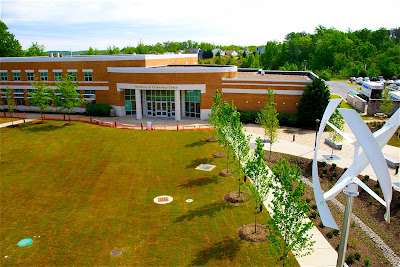Orange County students in a Germanna Licensed Practical Nursing class at Eastern View High in Culpeper. By the time they graduate from high school, they are prepared to be an LPN. Health care is one field with great demand for skilled workers.
BY HOWARD OWEN
The Free Lance-Star
It might not look like it now, with unemployment over 8 percent, but by the end of the decade, a major issue facing the United States could be a scarcity of qualified workers. Higher education in general and community colleges in particular can play a big role in reversing that trend.
That was the message sent recently by the Committee for Economic Development, a nonpartisan business group, in a teleconference and accompanying policy statement.
“One of the most important needs the country has,” said CED president Charles Kolb, “is to enhance the performance of the post-secondary education sector.”
The CED is encouraging businesses and colleges to work together to ensure that students are getting to colleges and that colleges are providing what they need to compete in a global market.
“We want to make sure that post-secondary education is ready for them,” said Marilyn Reznick, executive director of education leadership for AT&T. She said the CED is calling on “business, educational and policy leaders to be ready for lower-income, first-generation and non-traditional students.”
The CED wants to focus mostly on “broad-access” institutions—the less-selective and less-expensive public and private colleges and universities, the community and technical colleges and for-profit colleges.
Those, the CED believes, “are the only realistic options to expand capacity sufficiently to educate the large numbers of people who need skills for success in the workforce of the future.”
A message board is set to welcome students to Germanna's new Science & Engineering Building, set to open this month, with a ribbon cutting at 1 p.m. on Friday, May 11 at the Fredericksburg Area Campus in Massaponax. The high-tech building itself will be a teaching tool to prepare them for careers in those fields..
VIRGINIA PROGRAM CITED
Virginia’s higher education system was highlighted in the report as a leader in trying to reach those goals.
The state’s Achieve 2015 program was one of the efforts that drew attention. It is a six-year strategic plan for the state’s community colleges that aims for a 50 percent increase in students either completing a degree, transferring to a four-year school or earning a workforce credential by 2015, with a target of 75 percent for traditionally underrepresented students.
To meet the Achieve 15 goals, Germanna Community College President David A. Sam says GCC has “established a number of initiatives.
“One is to focus like a laser on what helps students learn and succeed, and continuously improve teaching and support services. Another is to better reach out to those who are in danger of being left behind, offering programs and services that fulfill the promise of affordable access to post-secondary education and training. We are also developing partnerships and alternative resources to better enable the college to achieve its mission.”
After being unable to complete high school, Terra Painter of Madison entered GCC's Middle College, which prepares students to pass the GED and be prepared to enter a degree program at a community college or four-year school.
...KEEPING COSTS DOWN
One of the largest issues the CED is seeking to address is college costs. Between 1982 and 2011, while the consumer price index went up 125 percent, college tuition and fees rose 570 percent. Between 1999–2000 and 2007–08, college costs as a percentage of median family income soared. In the middle income quintile, it rose from 18 percent to 25 percent. For the poorest one-fifth, it went from 39 percent to 55 percent. Total college loan debt is now over $1 trillion.
(One goal of Virginia’s Achieve 2015 plan is to keep tuition and fees at less than half the cost of attending the state’s public four-year schools, and to increase the number of students receiving financial assistance and scholarships by 36,000.)
The rising cost helps explain why younger Americans are falling behind the rest of the world in education.
In the last half of the 20th century, the United States led the world in proportion of its working-age population getting education beyond the high school level.
The U.S. is still near the top when you include all workers 25–64. When only younger adults are counted, though, it’s another story. In 2009, we ranked 15th in the world in percentage of workers 25–34 achieving an associate degree or higher.
Combine that fact with the baby boomer retirement tsunami that’s just beginning, and you get back to that anticipated shortage of workers in the near future. It’s estimated that we will have a 1.3 million deficit in college graduates by 2020, even if all states step up their games to the level of the highest-performing states.
Rocio Fernandez says Germanna's affordability made it possible for her to study engineering, a field in which America needs more graduates to stay competitive with emerging economic powers including China and India.
The CED is urging businesspeople to get more involved in their states’ college educational systems, to ensure that useful education is made available to as many as possible and as affordably as possible. The United States, the policy statement notes, “needs a well-educated workforce to innovate and move the economy forward.”
Dr. Sam at GCC agrees:
“Germanna and other community colleges must play a key role in Virginia’s—and America’s—competitiveness by pivoting quickly to educate and train people as the economy changes.”
GCC President Sam said: “In some cases, we must prepare people for jobs that didn’t even exist a few years ago or for occupations yet to be invented. To accomplish this, Germanna seeks to understand and even anticipate local business needs, and thus help close the ’skills gap,’ where jobs go unfilled because people aren’t trained to do them." MORE
GCC student John W. Tyler won a national science innovation award last year while undergoing treatment for Lymphoma. Doctors have told him he's beaten the disease.

























